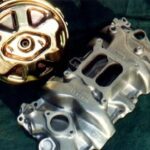While hemp boasts a history spanning over 10,000 years, it’s often perceived as a novel material in America. Although U.S. manufacturers are beginning to explore hemp’s potential, European counterparts have been leveraging its unique properties in automotive applications for decades. This has led to a significant disparity: European consumers readily find hemp components in their vehicles, while Americans seeking hemp-based automotive goods are largely limited to imports.
The slow adoption of industrial hemp in the American automotive sector is rooted in historical and legislative challenges. The “war on drugs” era saw hemp, despite its distinct properties from marijuana, entangled in restrictive legislation like the 1937 Marijuana Tax Act and the Controlled Substances Act of 1970. These policies effectively stalled the development of a domestic hemp industry.
However, the passage of the 2018 Farm Bill marked a turning point, federally legalizing hemp in the United States. This legislative shift has opened up substantial opportunities for manufacturers who have long awaited a viable hemp supply chain.
The Decarbonization Opportunity with Hemp Fiber in Auto Manufacturing
The question naturally arises: where can hemp fiber effectively contribute to decarbonizing manufacturing, particularly in the automotive industry? The answer lies in observing global markets, especially Europe, where hemp has proven its worth in textiles, construction, and crucially, automotive applications.
European automakers have consistently integrated hemp into various vehicle components, demonstrating its practical benefits. The widespread adoption across numerous manufacturers and diverse applications underscores hemp’s versatility and effectiveness.
Consider these examples of hemp car part applications already in use by European manufacturers:
- Body Panels
- Kick Pads
- Cup Holders
- Wheel Wells
- Dashboard Panels
- Interior Door Panels
- Upholstery
- Seatbacks
- Door Cladding
- Foam Seating
- Floor Insulation
- Panel Trim
- Center Consoles
A comprehensive 2016 study provides further in-depth analysis of hemp’s diverse applications in the automotive sector over past decades, highlighting its established history in European vehicle manufacturing.
Why Aren’t American Automakers Using Hemp Car Parts?
The primary obstacle for American automakers is the absence of a robust American industrial hemp supply chain. Without a reliable domestic source of hemp, U.S. manufacturers cannot readily replicate the successes and benefits realized by their European counterparts.
However, this situation presents a significant advantage for American companies. They can leverage the extensive research and development already undertaken by European automakers. Years of testing and substantial investments have validated hemp as a valuable automotive material, effectively shortening the R&D timelines for American manufacturers.
Proven Benefits of Hemp Fiber in Automotive Applications
European automakers have demonstrated several key advantages of using hemp fiber in car parts:
Enhanced Strength
Hemp fibers exhibit superior tensile strength compared to glass fibers. This allows manufacturers to achieve comparable structural integrity using less material, leading to potential material savings and lighter components.
Weight Reduction
Hemp fibers are lighter than glass fibers at a molecular level. Using hemp instead of glass fiber can reduce the weight of automotive parts by up to 44% for the same volume of fiber, contributing to overall vehicle lightweighting.
Cost Efficiency
While glass fibers often increase costs compared to traditional plastic fillers, hemp fibers offer a cost-effective alternative. Hemp can lower the cost of goods sold (COGS) while maintaining or even improving material performance characteristics.
Carbon Negativity
Hemp cultivation is environmentally beneficial. For every ton of hemp grown, approximately 2.85 tons of carbon dioxide are removed from the atmosphere. This carbon-negative characteristic contrasts sharply with glass fibers, which have a negative environmental impact often overshadowed by the petroleum industry’s influence.
These compelling benefits make hemp fiber a highly attractive proposition for automotive part manufacturers seeking sustainable and high-performance materials.
Hemp Fiber in Polypropylene (PP) and Polyethylene (PE) for Automotive Components
Hemp fiber particularly enhances two widely used plastics in the automotive industry: polypropylene (PP) and polyethylene (PE). These plastics are favored for their lightweight and cost-effective properties, contributing to efficient vehicle production.
Incorporating hemp fiber into PP and PE further reduces cost, weight, and the carbon footprint of these plastics without compromising part performance. This aligns perfectly with the automotive industry’s growing focus on lightweighting, a critical strategy for improving vehicle efficiency and reducing emissions. Lighter vehicles offer numerous advantages, including faster acceleration, extended range, increased payload capacity, lower emissions, and improved fuel economy.
Interestingly, hemp is not entirely new to American automotive history. Henry Ford famously constructed a car from hemp in 1941. This “hemp car” was lauded as the strongest and lightest vehicle of its time. However, Ford’s pioneering effort was ultimately hampered by the lack of a sustainable hemp supply chain, rendering mass production impractical.
Decades later, the challenge remains the same: establishing a reliable hemp supply chain. Companies like Heartland are now dedicated to building this crucial infrastructure, paving the way for American automakers to embrace hemp and develop the next generation of sustainable vehicles.
Join the movement towards a future built with hemp.
– Heartland Team
